Abstract
In recent years, it has become apparent that salicylic acid (SA) plays an important role in plant defense responses to pathogen attack. Previous studies have suggested that one of SA's mechanisms of action is the inhibition of catalase, resulting in elevated levels of H2O2, which activate defense-related genes. Here we demonstrate that SA also inhibits ascorbate peroxoidase (APX), the other key enzyme for scavenging H2O2. The synthetic inducer of defense responses, 2,6-dichloroisonicotinic acid (INA), was also found to be an effective inhibitor of APX. In the presence of 750 microM ascorbic acid (AsA), substrate-dependent IC50 values of 78 microM and 95 microM were obtained for SA and INA, respectively. Furthermore, the ability of SA analogues to block APX activity correlated with their ability to induce defense-related genes in tobacco and enhance resistance to tobacco mosaic virus. Inhibition of APX by SA appears to be reversible, thus differing from the time-dependent, irreversible inactivation by suicide substrates such as p-aminophenol. In contrast to APX, the guaiacol-utilizing peroxidases, which participate in the synthesis and crosslinking of cell wall components as part of the defense response, are not inhibited by SA or INA. The inhibition of both catalase and APX, but not guaiacol peroxidases, supports the hypothesis that SA-induced defense responses are mediated, in part, through elevated H2O2 levels or coupled perturbations of the cellular redox state.
Full text
PDF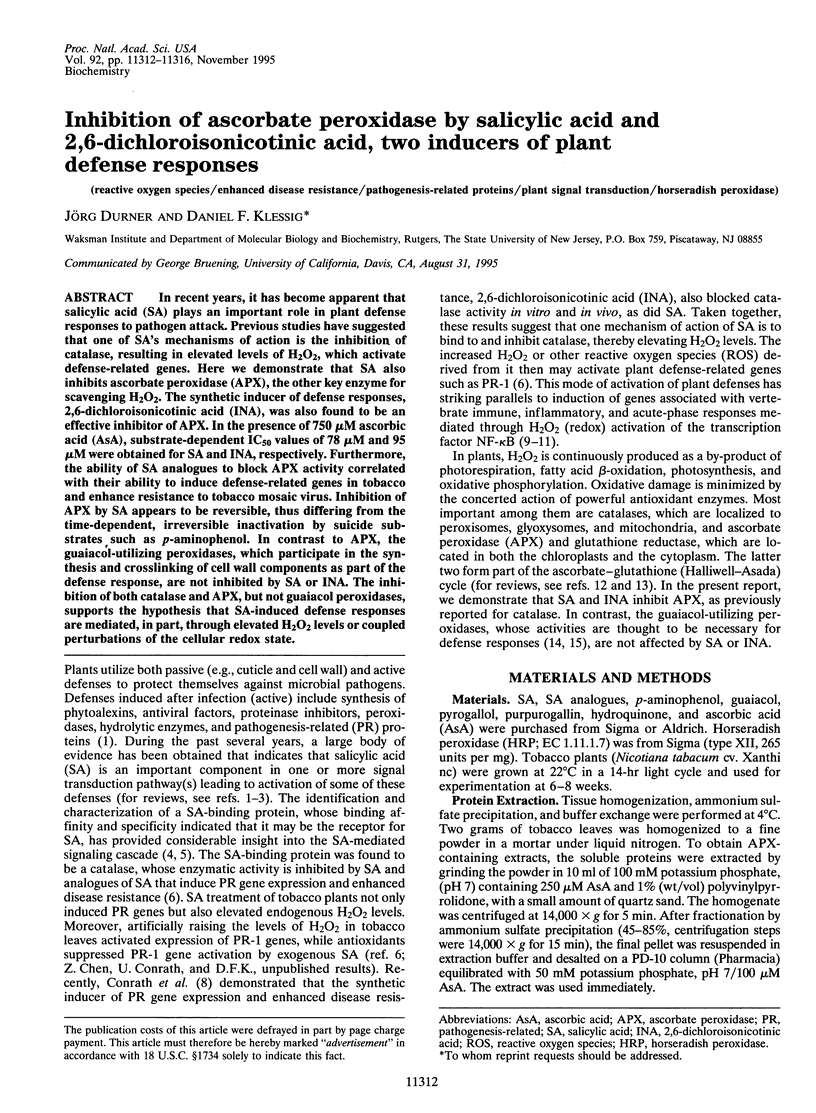
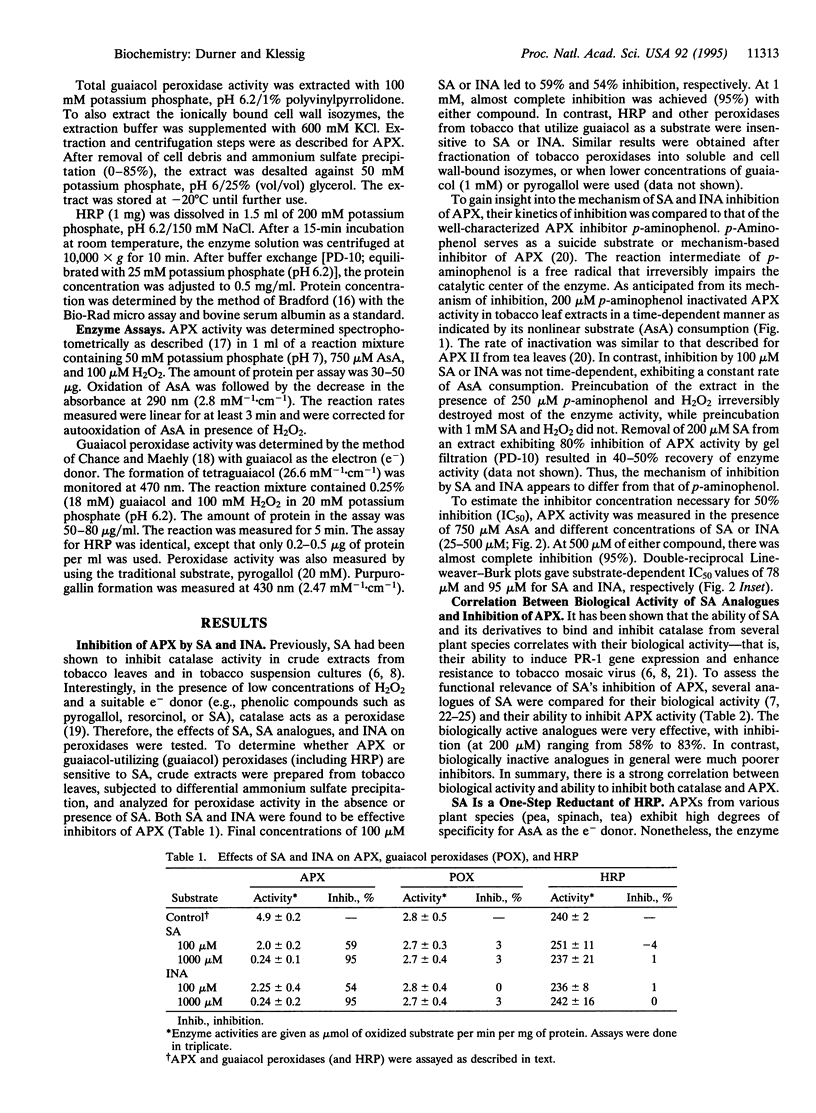
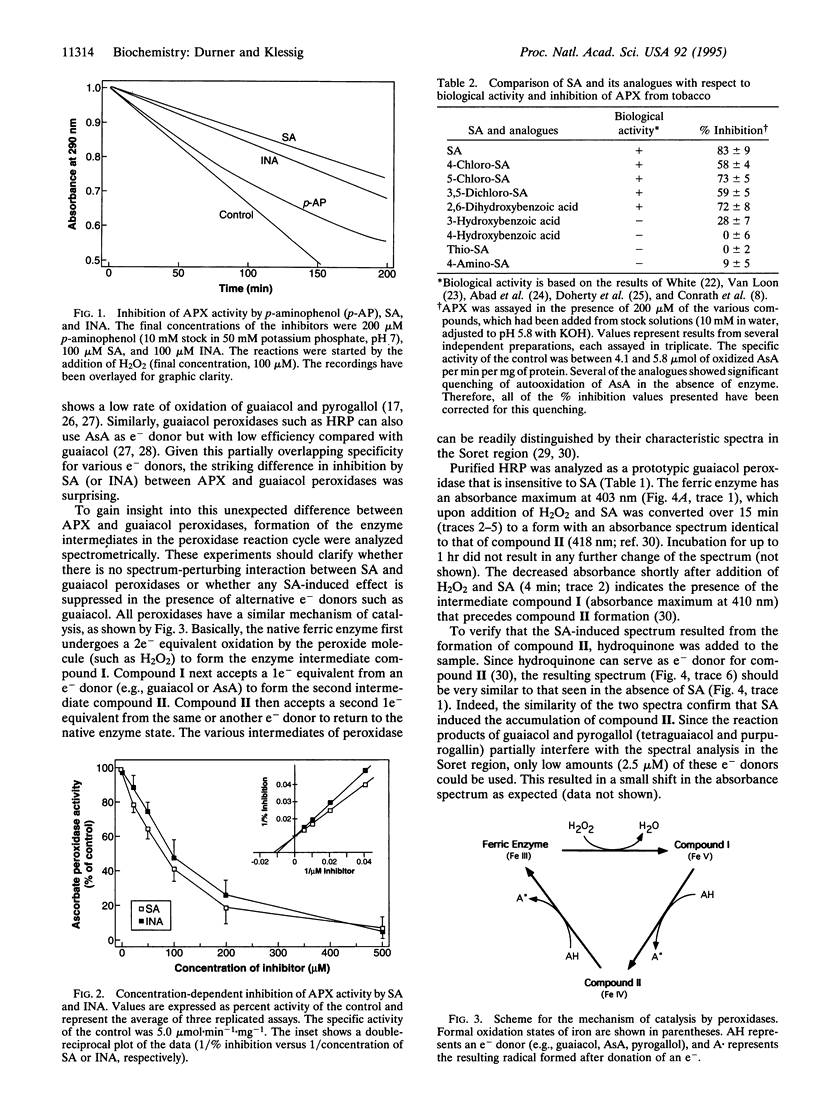
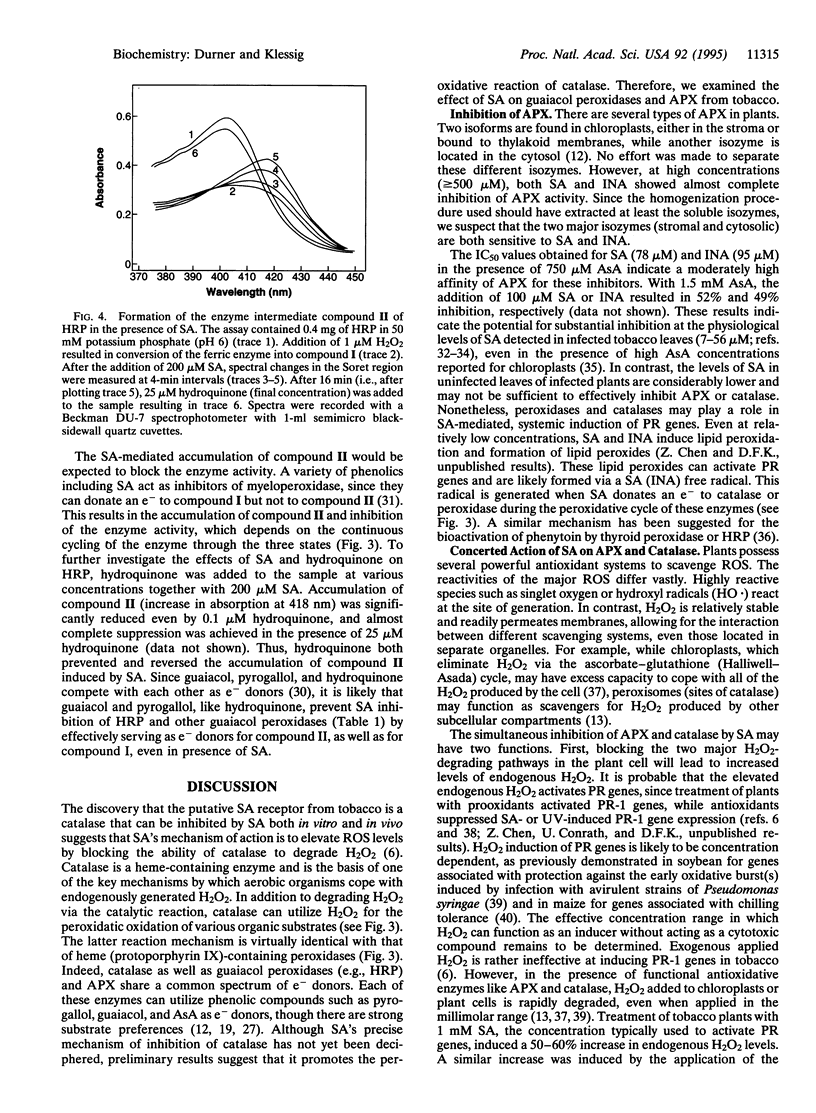
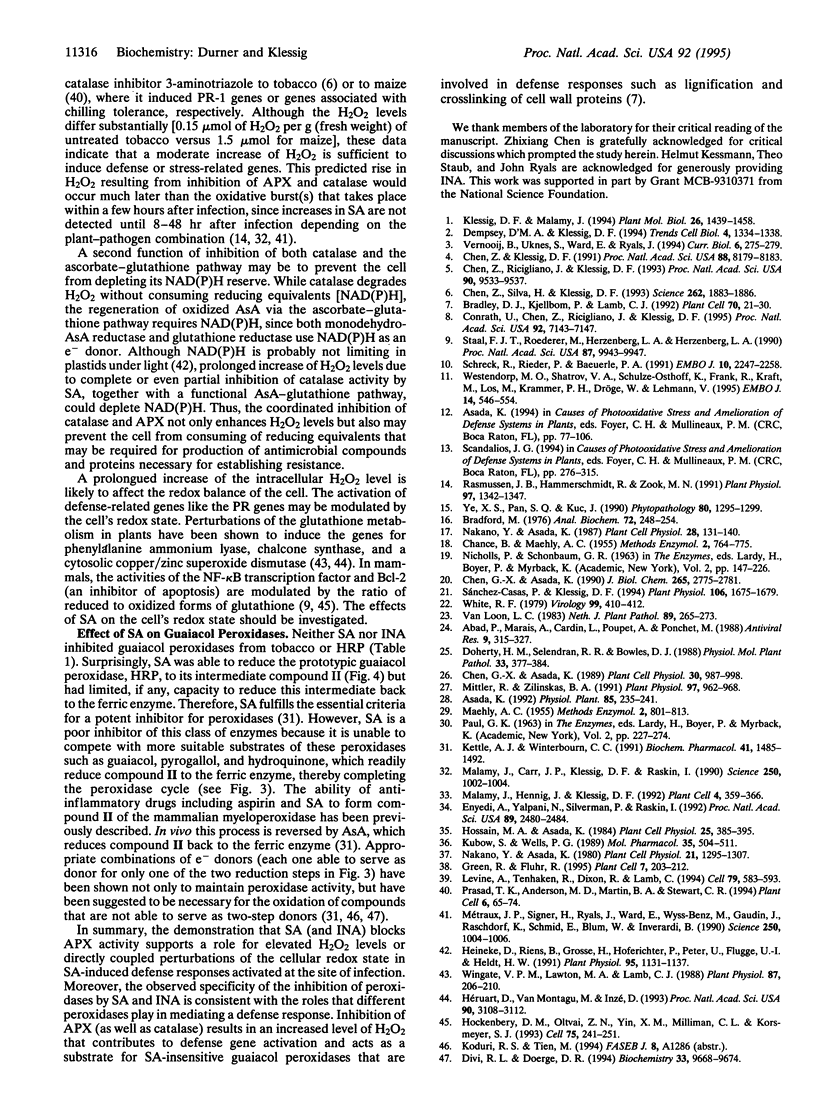
Selected References
These references are in PubMed. This may not be the complete list of references from this article.
- Abad P., Marais A., Cardin L., Poupet A., Ponchet M. The effect of benzoic acid derivatives on Nicotiana tabacum growth in relation to PR-b1 production. Antiviral Res. 1988 Aug;9(5):315–327. doi: 10.1016/0166-3542(88)90026-5. [DOI] [PubMed] [Google Scholar]
- Bradford M. M. A rapid and sensitive method for the quantitation of microgram quantities of protein utilizing the principle of protein-dye binding. Anal Biochem. 1976 May 7;72:248–254. doi: 10.1016/0003-2697(76)90527-3. [DOI] [PubMed] [Google Scholar]
- Bradley D. J., Kjellbom P., Lamb C. J. Elicitor- and wound-induced oxidative cross-linking of a proline-rich plant cell wall protein: a novel, rapid defense response. Cell. 1992 Jul 10;70(1):21–30. doi: 10.1016/0092-8674(92)90530-p. [DOI] [PubMed] [Google Scholar]
- Chen G. X., Asada K. Hydroxyurea and p-aminophenol are the suicide inhibitors of ascorbate peroxidase. J Biol Chem. 1990 Feb 15;265(5):2775–2781. [PubMed] [Google Scholar]
- Chen Z., Klessig D. F. Identification of a soluble salicylic acid-binding protein that may function in signal transduction in the plant disease-resistance response. Proc Natl Acad Sci U S A. 1991 Sep 15;88(18):8179–8183. doi: 10.1073/pnas.88.18.8179. [DOI] [PMC free article] [PubMed] [Google Scholar]
- Chen Z., Ricigliano J. W., Klessig D. F. Purification and characterization of a soluble salicylic acid-binding protein from tobacco. Proc Natl Acad Sci U S A. 1993 Oct 15;90(20):9533–9537. doi: 10.1073/pnas.90.20.9533. [DOI] [PMC free article] [PubMed] [Google Scholar]
- Chen Z., Silva H., Klessig D. F. Active oxygen species in the induction of plant systemic acquired resistance by salicylic acid. Science. 1993 Dec 17;262(5141):1883–1886. doi: 10.1126/science.8266079. [DOI] [PubMed] [Google Scholar]
- Conrath U., Chen Z., Ricigliano J. R., Klessig D. F. Two inducers of plant defense responses, 2,6-dichloroisonicotinec acid and salicylic acid, inhibit catalase activity in tobacco. Proc Natl Acad Sci U S A. 1995 Aug 1;92(16):7143–7147. doi: 10.1073/pnas.92.16.7143. [DOI] [PMC free article] [PubMed] [Google Scholar]
- Divi R. L., Doerge D. R. Mechanism-based inactivation of lactoperoxidase and thyroid peroxidase by resorcinol derivatives. Biochemistry. 1994 Aug 16;33(32):9668–9674. doi: 10.1021/bi00198a036. [DOI] [PubMed] [Google Scholar]
- Enyedi A. J., Yalpani N., Silverman P., Raskin I. Localization, conjugation, and function of salicylic acid in tobacco during the hypersensitive reaction to tobacco mosaic virus. Proc Natl Acad Sci U S A. 1992 Mar 15;89(6):2480–2484. doi: 10.1073/pnas.89.6.2480. [DOI] [PMC free article] [PubMed] [Google Scholar]
- Green R., Fluhr R. UV-B-Induced PR-1 Accumulation Is Mediated by Active Oxygen Species. Plant Cell. 1995 Feb;7(2):203–212. doi: 10.1105/tpc.7.2.203. [DOI] [PMC free article] [PubMed] [Google Scholar]
- Heineke D., Riens B., Grosse H., Hoferichter P., Peter U., Flügge U. I., Heldt H. W. Redox Transfer across the Inner Chloroplast Envelope Membrane. Plant Physiol. 1991 Apr;95(4):1131–1137. doi: 10.1104/pp.95.4.1131. [DOI] [PMC free article] [PubMed] [Google Scholar]
- Hockenbery D. M., Oltvai Z. N., Yin X. M., Milliman C. L., Korsmeyer S. J. Bcl-2 functions in an antioxidant pathway to prevent apoptosis. Cell. 1993 Oct 22;75(2):241–251. doi: 10.1016/0092-8674(93)80066-n. [DOI] [PubMed] [Google Scholar]
- Hérouart D., Van Montagu M., Inzé D. Redox-activated expression of the cytosolic copper/zinc superoxide dismutase gene in Nicotiana. Proc Natl Acad Sci U S A. 1993 Apr 1;90(7):3108–3112. doi: 10.1073/pnas.90.7.3108. [DOI] [PMC free article] [PubMed] [Google Scholar]
- Kettle A. J., Winterbourn C. C. Mechanism of inhibition of myeloperoxidase by anti-inflammatory drugs. Biochem Pharmacol. 1991 May 15;41(10):1485–1492. doi: 10.1016/0006-2952(91)90565-m. [DOI] [PubMed] [Google Scholar]
- Klessig D. F., Malamy J. The salicylic acid signal in plants. Plant Mol Biol. 1994 Dec;26(5):1439–1458. doi: 10.1007/BF00016484. [DOI] [PubMed] [Google Scholar]
- Kubow S., Wells P. G. In vitro bioactivation of phenytoin to a reactive free radical intermediate by prostaglandin synthetase, horseradish peroxidase, and thyroid peroxidase. Mol Pharmacol. 1989 Apr;35(4):504–511. [PubMed] [Google Scholar]
- Levine A., Tenhaken R., Dixon R., Lamb C. H2O2 from the oxidative burst orchestrates the plant hypersensitive disease resistance response. Cell. 1994 Nov 18;79(4):583–593. doi: 10.1016/0092-8674(94)90544-4. [DOI] [PubMed] [Google Scholar]
- Malamy J., Carr J. P., Klessig D. F., Raskin I. Salicylic Acid: a likely endogenous signal in the resistance response of tobacco to viral infection. Science. 1990 Nov 16;250(4983):1002–1004. doi: 10.1126/science.250.4983.1002. [DOI] [PubMed] [Google Scholar]
- Malamy J., Hennig J., Klessig D. F. Temperature-Dependent Induction of Salicylic Acid and Its Conjugates during the Resistance Response to Tobacco Mosaic Virus Infection. Plant Cell. 1992 Mar;4(3):359–366. doi: 10.1105/tpc.4.3.359. [DOI] [PMC free article] [PubMed] [Google Scholar]
- Mittler R., Zilinskas B. A. Purification and characterization of pea cytosolic ascorbate peroxidase. Plant Physiol. 1991 Nov;97(3):962–968. doi: 10.1104/pp.97.3.962. [DOI] [PMC free article] [PubMed] [Google Scholar]
- Métraux J. P., Signer H., Ryals J., Ward E., Wyss-Benz M., Gaudin J., Raschdorf K., Schmid E., Blum W., Inverardi B. Increase in salicylic Acid at the onset of systemic acquired resistance in cucumber. Science. 1990 Nov 16;250(4983):1004–1006. doi: 10.1126/science.250.4983.1004. [DOI] [PubMed] [Google Scholar]
- Prasad T. K., Anderson M. D., Martin B. A., Stewart C. R. Evidence for Chilling-Induced Oxidative Stress in Maize Seedlings and a Regulatory Role for Hydrogen Peroxide. Plant Cell. 1994 Jan;6(1):65–74. doi: 10.1105/tpc.6.1.65. [DOI] [PMC free article] [PubMed] [Google Scholar]
- Rasmussen J. B., Hammerschmidt R., Zook M. N. Systemic Induction of Salicylic Acid Accumulation in Cucumber after Inoculation with Pseudomonas syringae pv syringae. Plant Physiol. 1991 Dec;97(4):1342–1347. doi: 10.1104/pp.97.4.1342. [DOI] [PMC free article] [PubMed] [Google Scholar]
- Sanchez-Casas P., Klessig D. F. A Salicylic Acid-Binding Activity and a Salicylic Acid-Inhibitable Catalase Activity Are Present in a Variety of Plant Species. Plant Physiol. 1994 Dec;106(4):1675–1679. doi: 10.1104/pp.106.4.1675. [DOI] [PMC free article] [PubMed] [Google Scholar]
- Schreck R., Rieber P., Baeuerle P. A. Reactive oxygen intermediates as apparently widely used messengers in the activation of the NF-kappa B transcription factor and HIV-1. EMBO J. 1991 Aug;10(8):2247–2258. doi: 10.1002/j.1460-2075.1991.tb07761.x. [DOI] [PMC free article] [PubMed] [Google Scholar]
- Staal F. J., Roederer M., Herzenberg L. A., Herzenberg L. A. Intracellular thiols regulate activation of nuclear factor kappa B and transcription of human immunodeficiency virus. Proc Natl Acad Sci U S A. 1990 Dec;87(24):9943–9947. doi: 10.1073/pnas.87.24.9943. [DOI] [PMC free article] [PubMed] [Google Scholar]
- Vernooij B., Uknes S., Ward E., Ryals J. Salicylic acid as a signal molecule in plant-pathogen interactions. Curr Opin Cell Biol. 1994 Apr;6(2):275–279. doi: 10.1016/0955-0674(94)90147-3. [DOI] [PubMed] [Google Scholar]
- Westendorp M. O., Shatrov V. A., Schulze-Osthoff K., Frank R., Kraft M., Los M., Krammer P. H., Dröge W., Lehmann V. HIV-1 Tat potentiates TNF-induced NF-kappa B activation and cytotoxicity by altering the cellular redox state. EMBO J. 1995 Feb 1;14(3):546–554. doi: 10.1002/j.1460-2075.1995.tb07030.x. [DOI] [PMC free article] [PubMed] [Google Scholar]
- Wingate V. P., Lawton M. A., Lamb C. J. Glutathione causes a massive and selective induction of plant defense genes. Plant Physiol. 1988 May;87(1):206–210. doi: 10.1104/pp.87.1.206. [DOI] [PMC free article] [PubMed] [Google Scholar]


